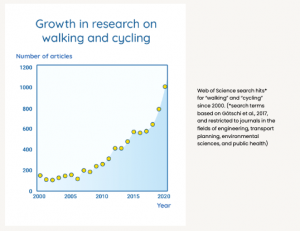This blog was written by Dr Adrian L Davis, Professor of Transport & Health, Transport Research Institute at Edinburgh Napier University.
Since a few early studies, including the UK Whitehall Study (started 1967) which especially focused on cardiorespiratory disease prevalence, and a Birmingham male factory workers study (1986) of commuter cyclists, there began a trickle of evidence suggesting that walking and cycling provide significant health benefits. The headline was reduced all-cause mortality and for cycling higher fitness levels equivalent to being five to ten years younger. Then, from around 2000 there was a sharp increase in peer reviewed research, likely led by sport scientists getting more interested in population health. Then other scientists got interested.

So, why this new World Health Organisation (WHO) report? Well, the four main premises are:
- These are good times for advancing walking and cycling
- Walking and cycling are central to urban mobility – rather than an afterthought
- Research provides a strong case to promote walking and cycling
- Practice provides a rich portfolio of measures to promote walking and cycling
The target audience is firstly policy makers by providing support to make the case for more walking and cycling. Secondly, it’s for practitioners by providing an overview of effective measures. Thirdly, advocates can draw on this evidence to help develop a narrative of the most compelling arguments in favour of walking and cycling. Fourth, it’s also accessible for general readers as we take you through the breadth of research findings with further readings references.
Why now? There are quite a few good reasons, not least: COVID-19 and the lessons that travel patterns can change quickly and so can some infrastructure; more urgent Climate change challenges; electrification and E-bikes, other technological advances; and the need for equity in transport. Taking e-biking, the battery energy support and the expanded km range etc, has led to a broader demographic market, including those long-ago lapsed cyclists aged 60+. Across Europe we continue to witness substantial sales growth. That’s the up-side. On the downside we also see that e-biking is about twice as risky as cycling (based on Swiss data).
More generally, we must address perceived and actual harms which starts with road danger. Higher safety can be achieved through infrastructure and traffic regulation, a prerequisite for higher walking and cycling levels. In terms of air pollution, the evidence remains that physical activity benefits outweigh harms from pollution exposure although we must deal with this issue. In putting benefits and harms into perspective we highlight the increasing value of the Health Economic Assessment Tool. The HEAT is designed to enable users without expertise in impact assessment to conduct economic assessments of the health impacts of walking or cycling. Case studies are included. We hope they inspire. Just look at Seville (p 67), for example, to see what can be achieved with political will.
We conclude that a rich body of evidence finds that there are substantial benefits accruing from walking and cycling, for individual and population health. Moreover, their role in replacing existing car trips, helping move towards carbon-free mobility, is increasingly recognised. The challenge: current planning practice needs to realign prioritisation of travel modes regarding funds and space away from private cars and recognise active travel as central – not an afterthought – to meeting a broad set of policy goals including health and sustainability. Ending on a personal note, we largely know the infrastructural measures needed, we have to work hard to resolve the human behaviour challenges – embedded as they are in cultural norms – and re-enforced by spatial planning. In Scotland government policy is reflecting better the evidence-base although that does not alone guarantee success. We all need to take meaningful action, as advocates, and in how we choose to move around.
Read the full WHO report here: Walking and cycling: latest evidence to support policy-making and practice (who.int)
